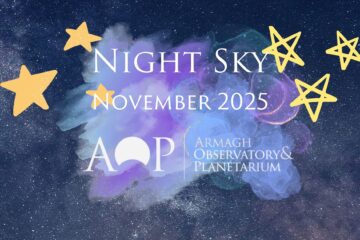Some good news folks! If you fancy a few free ‘sparklers’ to get you celebrating, you could fill a bag with the number of fabulous looking stars that will appear their prettiest again this month against the darkest seasonal drape of the year as it stretches in all directions above your head.
Well there’s no contest, during the winter months the constellation of Orion effortlessly remains “king of the ring” among the various constellations that belong to, and put on a show, in the ‘Winter Circle’ of brightest stars. As already mentioned by Stephen last month, Orion displays not only a hoard of glittering gems against the black velvet of Space – but the hunter boasts celestial gems of different types; from the sapphire-like supergiant star at his right foot – Rigel, to that massive ‘ruby’ at his left shoulder, a star approximately 900 times the diameter of our Sun – Betelgeuse. However, no matter what direction you are facing outdoors, let your eyes wander and that spectacular slanted line of apparently equidistantly-spaced stars of Orion’s belt will draw your eyes like a magnet! So let’s take a closer look.

The stars of Orion’s belt, located at the top of this image, are three of the most iconic stars in the winter night sky. Cradit: Nick Parke/Stellarium
These stars are called (from left to right) – Alnitak, Alnilam and Mintaka or ‘the three kings’. Beneath this spectacular asterism is, what will appear to be (to the naked eye anyway) a vertical line of about 4 stars. However on closer inspection, if you have a pair of binoculars or a telescope handy, you will be able to see that the penultimate bright object from the bottom of this ‘line’ is something a bit fuzzier and larger than a single star.

A prolific jewel of the winter night sky, the Orion Nebula can even be seen from within the bright depths of a city! Credit: Solsticeman/Wiki Commons
The object that your eyes are resting on is no less than M42, a great star-forming factory actually about 25 light years in diameter (where 1 light year is equal to 5.9 trillion miles), and was the first of its kind to ever be photographed back in 1880, by the American astronomer William Huggins. A bigger telescope, however, would grant you a better view of this amazing and colourful structure of dust and gas that tends to look like the lamp and reflector of some huge spotlight up in space. Instead of ‘1 lamp’ at the centre of M42 or the Orion Nebula though are the 4 biggest and brightest stars, known as the Trapezium Star Cluster as these luminous stars are arranged in a trapezoid pattern. The Orion Nebula is also the closest massive star-forming region to Earth at approximately 1300 light years away.
Like people, stars can sometimes be seen to be ‘hanging out’ in each other’s company in space – as can be seen in that open cluster of hot young stars, the Pleiades, thought to be a mere 100 million years old. It’s not too hard to spot this extremely popular astronomical feature of the night sky in the constellation and sign of the Zodiac – Taurus the bull. However a fun way to find it is to run your finger upward through the Three Kings and continue shooting upward into space at this angle.
Your finger should practically land on top of the Pleiades or ‘daughters of Pleione’, also known as the ‘seven sisters’ or “sailing ones”. (On the other hand, if you’ve a taste for the horror genre, you might prefer to call them the “Seven Little Eyes” or in Hawaiian: Na hiku o Makali’i, as this is how James Michener refers to them in his novel ‘Hawaii’!) Although the stars will spread out over time – thanks to the long lifespan of stars we can enjoy the prospect of observing the daughters of Atlas and Pleione; Sterope, Caleano, Taygeta, Maia, Electra, Merope and Akyone together as a family in the heavens for probably another 250 million years. Although thanks to today’s light pollution you’ll be doing well to identify 6 stars of the Pleiades with your naked eye, over 1000 stars are actually known to exist in this open cluster.
Last but not least, if you’ve kept up with all the observing so far – this last celestial object will literally be your reward! Can you remember from last month’s article how to find Sirius, ‘the dog star’? Between it and the constellation of the little dog, Canis Minor above – is the lesser known star pattern of the unicorn, Monoceros.

If anyone ever asked you if you believe in Unicorns, all you have to say is YES, they’re up in the sky! Credit: Nick Parke/Stellarium

The beautiful Rosette Nebula, found within the cheek of the Unicorn. Credit: Andreas Fink/Wiki Commons
In its nostril or cheek, with a powerful telescope, you might just catch a glimpse of a beautiful but faint rosette in space, known as the Rosette Nebula. This large nebula is about 5000 light years away but larger than the Orion Nebula at 130 light years across. NGC 2244, a fantastic open cluster of stellar diamonds decorates the centre of this impressive nebula. So plenty to look out for in the heavens this month, don’t forget to wrap up warm and happy hunting!
Article written by: Nick Parke





1 Comment
The January Night Sky 2018 – MeasurementDataBases for Industry & Science · January 15, 2018 at 12:58
[…] Astronotes Astronotes: Some good news folks! If u fancy a few free ‘sparklers’ to get you celebrating, […]